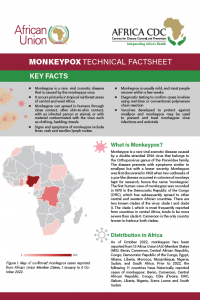KEY FACTS
● Monkeypox is a rare, viral zoonotic disease that is caused by the monkeypox virus
● It occurs primarily in tropical rainforest areas of central and west Africa
● Monkeypox can spread in humans through close contact, often skin-to-skin contact, with an infected person or animal, or with material contaminated with the virus such as clothing, bedding, towels
● Signs and symptoms of monkeypox include fever, rash and swollen lymph nodes
● Monkeypox is usually mild, and most people recover within a few weeks
● Diagnostic testing to confirm cases involves using real-time or conventional polymerase chain reaction
● Vaccines developed to protect against smallpox and monkeypox may be used to prevent and treat monkeypox virus infections and antivirals.
What is Monkeypox?
Monkeypox is a rare viral zoonotic disease caused by a double stranded DNA virus that belongs to the Orthopoxvirus genus of the Poxviridae family.
The disease presents with symptoms similar to smallpox but with a lesser severity. Monkeypox was first discovered in 1958 when two outbreaks of a pox-like disease occurred in colonies of monkeys kept for research, hence the name ‘monkeypox.’
The first human case of monkeypox was recorded in 1970 in the Democratic Republic of the Congo (DRC), which has subsequently spread to other central and western African countries. There are two known clades of the virus: clade I and clade II. The clade I, which is most frequently reported from countries in central Africa, tends to be more severe than clade II. Cameroon is the only country known to harbour both clades.
